A new epoch of the U.S. labor movement may be dawning. Despite apparent setbacks, like the Supreme Court’s anti-union decision in the Janus vs. AFSCME case, workers are often sidestepping union bureaucracy and applying creative tactics to counter decades of anti-labor legislation. This is beginning among teachers, but every worker should watch and learn.
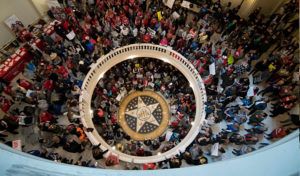
Early in 2018, teachers in Arizona, Colorado, Oklahoma, Kentucky, and West Virginia initiated work stoppages in response to bad contracts and anti-teacher legislation. These strikes and walkouts featured daring and ingenious tactics devised by the educators themselves. Instead of letting union bureaucrats and the school boards bargain for months on end, rank-and-file teachers organized sit-ins and occupations of their state capitols and legislatures—where the real bosses of the public school system convene. Furthermore, these teachers used social media to react in real-time to threats and to develop informal communication networks that allowed for mobilization of the ranks and for interstate collaboration. These new tactics suggest that the U.S. labor movement could be making a long overdue return to the methods of class struggle.
It is important to recognize the teachers and their movement for what it is. The teachers are teaching a lesson to the entire labor movement—react immediately to fight injustices as they occur. If the labor bureaucrats try to delay direct action until after contract negotiations, then organize a walkout and galvanize community support on your own. Fed up with a sclerotic, docile labor bureaucracy, the teachers are turning their labor movement into an agile, rapid-response fighting force. The teachers are teaching, the workers are learning, and the school boards and union bureaucrats are watching with alarm.
Bypassing typical union negotiations has now become necessary for the survival of organized labor. On June 27, 2018, In Janus v. AFSCME, the Court held that the First Amendment prohibits public employee unions from charging a mandatory fee for costs of representation, overturning its 1977 decision in Abood v. Detroit Board of Education. In other words, the U.S. Supreme Court declared that all public-sector workers will now be covered under the so-called “right to work” legal framework that denies unions the ability to charge workers dues. The ruling also makes union membership opt-in rather than opt-out. The costs and burdens on organized labor will be significantly increased, possibly for decades to come. If this stands, Labor should relearn the art of convincing workers to belong to a union and voluntarily pay their dues. That is how the unions were built in the first place.
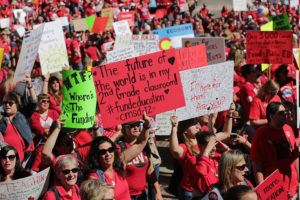
Still, the teachers’ strikes of 2018 show how Labor can fight the entire corpus of anti-labor legislation at the local, state, and federal level. Change will not happen by spending money to lobby elected officials nor supporting Democratic or Republican electoral candidates. Organized labor and its tools, the unions, were born out of struggles, not laws. If unions are to rise again, it will be by following the example of the teachers, and attacking the bourgeoisie with coordinated labor actions, especially strikes. And the labor movement should defy every law in the book that diminishes its capacity to organize.
Against Labor Bureaucrats
Independent labor action brings workers into conflict with official union leadership. Traditionally, these bureaucrats have collaborated with elected officials to bog down, delay, demoralize, and distract education workers from their objectives. School board members work to keep tax bills for big businesses and wealthy people as low as possible, while relying on the full support of the official union leadership, who in turn rely on inactivity within the union ranks to maintain their power. Further, elected representatives from the Democratic and Republican parties that oversee the public school budgets have entrusted these bureaucrats with keeping workers on the job. This is why the union bureaucrats can be counted on to resist and undermine rank-and-file workers’ efforts to improve their wages and working conditions.
For instance, in West Virginia, the union leadership was prepared to accept a 2% raise on the teachers’ behalf. The teachers rejected this agreement and pressed on with their strike “illegally.” Through this independent action, West Virginia teachers won a 5% raise, more than double what the bureaucrats had negotiated. The next step for West Virginia teachers will be replacing their leadership at the first opportunity.
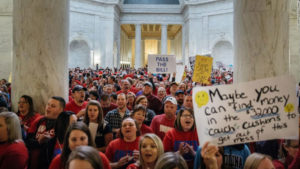
Inspired by West Virginia, rank-and-file teachers in Kentucky and Oklahoma both initiated strike actions. In Kentucky, the leadership of the Kentucky Education Association flatly opposed the teachers going out on strike. In Oklahoma, the union leadership called for a premature end to the strike, resulting in teachers’ raises significantly lower than what they fought for. In both of these cases, teachers could have benefited from a democratic structure within the union that would have allowed them to replace the leadership that failed to adequately press for their demands.
In Colorado, the union appeared to represent the will of its members. However, the Colorado Education Association’s leadership presumed that any increase in wages or school funding would need to be funded by a voter approved tax increase as mandated by the Colorado Taxpayers’ Bill of Rights. As it happened, the issue was resolved at the top when the Governor approved a 2% wage increase and the restoration of some degree of school funding without raising taxes on workers. Still, the bureaucrats’ disastrous policy of accepting the state mandate that they take labor negotiations to the ballot box would have completely undercut the teachers’ ability to use their organized strength directly against their bosses in the capitol and legislature.
The Arizona teachers won the largest salary concessions, with a 19% wage increase over the next three years. However, the union bureaucrats called off the strike before the ranks were ready, and the teachers did not receive what they demanded with respect to their working conditions. For example, the unions have demanded that the teachers get paid for all work they do outside their regular hours (grading papers, preparing classes, overtime work during fieldtrips) We should demand “An Hour Worked, An Hour Paid.” In this case, as throughout the entire history of the U.S. labor movement, rank-and-file teachers were willing to fight for what they need, while the union bureaucrats were not. In order to get the kind of public education system we need, teachers must become independent from the union bureaucrats, who are little more than the Labor Lieutenants of Capital.
The renewal of union leadership should be based on the principles of workers’ democracy, with leaders subject to replacement by immediate recall the moment their actions are counter to the interests of the rank-and-file.
Teachers should form school committees and citywide, statewide, and nationwide organizations that provide a means of unity and solidarity through the fiercest of struggles. They must fight for one union for all school employees: teachers, assistants, school bus drivers, janitors, councilors and administrative jobs, all covered by one contract, with one expiration date, and, if possible, at the national level.
Against Democrats and Republicans
Independent action from the ranks undermines a core function of the union officers: financial and political support for their bosses, the Democrats. Teachers must reclaim their profession from their enemies, Democrat and Republican alike, who scrap public education in the dustbin of worldwide austerity measures.
Most Supreme Court Justices that supported the Janus decision were confirmed into their position with bipartisan support. Anti-labor laws and the diversion of public school funds into private or semi-private charter schools show Democrats and Republicans happily cooperating to completely dismantle public education and the U.S. labor movement itself.
Last August, voters in Missouri supported by a margin of 2-1 a proposal to scrap anti-labor, “right to work” legislation showing that there is a will by many workers to fight against these initiatives. These state fights on the ballot, however, would not affect the Janus decision. Much more concerted, radical mobilization of the working class will be needed to overturn it.
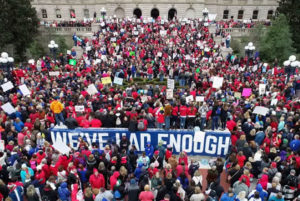
In Kentucky, thousands of teachers and supporters stormed the capital on March 21, demanding that their pensions—and the pensions of all state employees—be preserved. Although they lost this battle, the increase in labor activism stemming from this protest has emboldened many teachers in Kentucky to run against the very politicians who are trying to disassemble the state pension system. Over 40 educators filed their intention to run for the state legislature. In the May 22nd primary elections, 20 of these teachers ran in contested primaries, and 12 of them won.
Oklahoma teachers who were denied full salary increases after their strike action in April responded by running candidates from their own ranks to replace the legislators who denied them. In recent primary elections, 112 candidates who were either teachers, support staff, administrators, retired educators, or immediate family members of education workers stood for a place on the ballot, and 71 of them advanced to the November general election. Teacher candidates may replace nearly half of the sitting Oklahoma state representatives and senators—a sharp rebuke to the legislators who refused their demands.
This is a proper use of the ballot box: to punish legislators who have continuously sacrificed teachers to the idols of privatization and austerity. Also, teachers are absolutely correct to try to seize control of their own education budgets. Yet when teachers run as Democrats (or, in some strange instances, as Republicans), they ensure failure. If they win under these circumstances, they immediately become accountable to big-money donors and the party leadership rather than the teachers and students they were elected to represent. In all likelihood, these teachers-turned-legislators will soon be responsible to explain to the teachers who placed them in office why there isn’t money to pay teachers living wages, provide adequate school funds, or guarantee secure pensions. Their personal political survival will depend upon it.
Furthermore, teachers who win elections as members of one of the two big bourgeois parties allow the enemies of the working class to co-opt the teachers’ brave actions and militant energy. “The Democratic Party is trying to capitalize on the moment,” writes Dana Goldstein of the New York Times. “The Democratic National Committee plans to register voters at teacher rallies, and hopes to harness the movement’s populism.” In other words, the Democrats are attempting to control, subdue, and exploit the teacher uprisings and neatly repackage them as populist voter-registration ice-cream socials.
Teacher candidates must disabuse themselves of the notion that they can effect change merely by becoming representatives in the bourgeois government. They should instead campaign for office in order to expose the corruption of the bourgeois political superstructure, while strengthening connections with the parents, workers, and students they serve. If elected, they should use the platform and access granted them to further expose the machinations of the bourgeoisie and their representatives, and offer their experience to other workers. Most importantly, they must remain fully accountable to the workers they represent.
Regressive Taxation
While the U.S. government has seemingly unlimited funds for organized state violence both at home and abroad, many teachers use their own meager pay for essential classroom supplies. As public educational infrastructure continues to decay, educators are often forced to resort to voter approved tax increases to fund their efforts.
These are often in the form of property taxes, which are nearly always applied regressively. That is, all property owners are taxed at the same rate regardless of the value of their property or the income of their owners. In many cases, landlords are allowed to pass the cost of the property taxes onto their tenants. Teachers know this, which is why the Oklahoma teachers fought to fund their raises with progressive taxation.
Just this year, the United Educators of San Francisco, which represents more than 6,000 SFUSD employees, announced a tentative agreement on a 7% raise for teacher salaries with the San Francisco Unified School District. However, this pay raise was made contingent on the passing of Proposition G, levying a tax of $298 per year on all property owners except seniors whose property is their primary residence.
This is a perfect example of a regressive tax: the owners of gilded palaces in affluent neighborhoods pay the same tax as property owners in working-class neighborhoods. The ballot measure passed and the teachers will get their raise. The way they got it, however, was by unfairly taxing many San Francisco homeowners, with many teachers and other workers among them.
There are many other ways to generate revenue. First of all, we should not let the bosses pass their responsibility onto the electorate. We should always negotiate directly with bosses, fighting them on the picket lines when necessary, instead of begging voters for money. We should be heavily taxing the tech and financial sectors of the economy, which somehow manage to evade increased taxation most of the time.
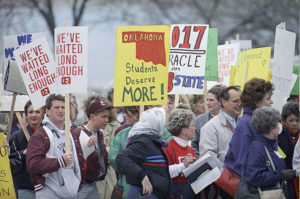
We should also slash the budgets of the police and sheriffs’ departments, which are used to in part to oppress the students and their families, especially those from communities of color and divert the funds to education. All subsidies for private schools should be stopped and those monies returned to public schools.
However, the union leaders and the elected representatives from the bourgeois parties—which in cities like San Francisco and Seattle means only Democrats—prefer to protect moneyed interests from paying their fair share. This is yet another reason for the teachers to separate from the political parties of the nation’s wealthiest citizens, and fight to govern their own lives, careers, and futures, alongside other workers, in a shared political organization.
The goal of our efforts should be fully funded schools with all education workers paid a living wage tethered to the actual cost of living. School funding should be 100% derived from taxing big businesses, the rich, and through other sources of progressive financing. This is the future for which we are organizing.
Private, Religious and Charter Schools
For decades, public, universal, and secular education has been undermined, and private and religious schools receive funds that could otherwise be used to greatly improve public education.
There are 34,576 private schools in the United States, serving 5.7 million Pre-K t 12th grade students. Private schools account for 25 percent of the nation’s schools and enroll 10 percent of all Pre-K to 12th students. 78% of all private school students attend religiously affiliated schools (PSS Report). This means that more than 38% of all public monies spent in education goes to them. Teachers must fight to recover those funds as they pay for them with bad wages and worsening working conditions.
Catholic and other non-government schools receive the bulk of their government funding from the federal government. However, they also receive funding from state governments. Thus, each state and territory has its own arrangement for funding non-public schools. Arizona, Colorado, D.C., Florida, Georgia, Indiana, Louisiana, Maine, Ohio, Oklahoma, Utah, Vermont, Wisconsin and other states offer vouchers to attend private schools. A number of states have tax credit programs that partially subsidize private schools.
In religious schools, students are taught religion–infringing upon the separation of church and state, since they are funded by public monies—and increasingly bow to the demands of industry—ignoring outright most modern progressive educational research. Both private and religious schools pay teachers an average of 20% less than their public school peers do. Private religious and charter schools are exempt from many regulations in regards to curricula and standards.
Another key factor in the deterioration of the U.S. public school system is the granting of charters to private or semi-private interests to use public money to administer schools. Forty-three states and the District of Columbia have enacted charter school laws, with Alabama being the latest in March 2015. (The seven states that do not have charter school laws are Kentucky, Montana, Nebraska, North Dakota, South Dakota, Vermont, and West Virginia.) Over the past five years, student enrollment in charter schools has grown by 62 percent. In 43 states and the District of Columbia, more than 2.9 million students now attend charter schools —which is more than six percent of the total number of students enrolled in all public schools.
Democrats and Republicans alike often portray charter schools as a way to rejuvenate the public school system that they have increasingly deprived of funding over decades. In reality, charter schools benefit students from wealthy families at the expense of working class and poor. For instance, Arizona’s vast network of charter schools, BASIS, “…discourages disadvantaged students from applying,” writes Carol Burris, a former New York high school principal. BASIS offers no transportation and has no free-lunch program. Burris: “There are also hefty ‘suggested’ parental contributions. BASIS ‘requests’ that families contribute at least $1,500 a year per child to fund its teacher bonus program. Enrollees must also pay a $300 security deposit, purchase some books, and pay for activities that would be free if the student attended a public school.”
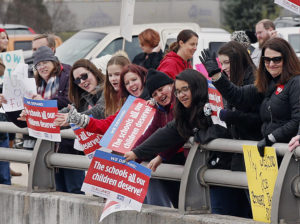
Unsurprisingly, charter schools contribute to the working conditions against which teachers are rebelling. To take the example of Arizona again, while the public school teachers received among the lowest salaries in the nation, the Democrats and Republicans in that state changed the language in their school funding bill such that the $4 billion budget increase would be shared with charter schools. These funds should have been used to raise teachers’ pay as well and pay for capital improvements and classroom materials in the public school system.
Furthermore, at the national level, there is a bipartisan conspiracy to fragment the traditional public school systems into networks of charter schools, many of them operated by private school administration firms that resemble private prison operators. Nina Rees, the chair of the national chapter of the National Alliance of Public Charter Schools, defends her lobotomization of public education as she says, “For 26 years, Democrats (such as Presidents Bill Clinton and Barack Obama) and Republicans (such as Presidents George W. Bush and Donald Trump) have worked together to expand charter school opportunities.” Then she has the gall to state that, “This is a polarizing time in Washington and around the country. But helping students get a great public education shouldn’t be a polarizing issue. It should be a core commitment that unites us all.”
What Rees does not tell her readers is that this charter school expansion, if left unchecked, is not an “opportunity,” but a death warrant for public schools. Charter schools are unaccountable; they do not have the same reporting mandates as their public school peers; they can inflate their graduation rates and other data to give the illusion that they are out-performing public schools—when, in actuality, their drop-out rates far exceed that of public schools and their testing performance lags behind. And few charter schools allow unions for teacher protection.
At a minimum, private schools should be completely financed by their owners. Private and religious schools must be deprived of subsidies, taxation exceptions, and other advantages as a transitory measure towards bringing these schools into 100% public control. All those monies should be invested in public education. In both public and private schools, there should be a complete separation from churches and they must be governed entirely by secular institutions.
Teachers and communities should demand social ownership and social control of all education. All public schools, from pre-kindergarten to university, should be incorporated into a democratic federation of schools administered directly by elected councils of teachers, students, education workers and parents.
All sitting on this council would be subject to immediate recall by a vote of the membership, but would also possess full power over budgets and curricula. Education corporations would get nothing, and bourgeois politicians would have no power over or within this council.
Student Solidarity
Following the shooting at Marjory Stoneman Douglas High School on February 14, 2018, students there and elsewhere have shown us the power of student activism against violence in schools. Students everywhere should feel empowered to protest and take direct action over legislation that denies them a quality education. Teachers and students should lead this fight, not bourgeois politicians and union bureaucrats. Under the bourgeois order, the House, Senate, and all other executive and legislative bodies of government exist to protect and advance the interests of the bourgeoisie. Only mass movements force concessions, and only mass movements can defend these concessions once they are made.
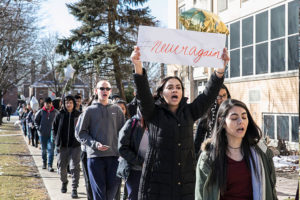
Students are directly affected by everything we have discussed thus far, and they need to step into leadership roles. Student caucuses should work with teachers to organize walkouts and strikes. If students join teachers as equal partners in this historic movement and win the support of all school workers and parents, their combined power can finally begin to rebuild the U.S. public school system after decades of neglect and malfeasance.
The students at Marjory Stoneman Douglas High School have received no concrete action in responses to their activism. Instead, Democrats channeled their very specific requests for safety into a Democratic get-out-the-vote campaign and voter registration drives.
The students across this country would do much better to align themselves with labor struggles and develop a solidarity movement that extends outside of the schools. Students should participate in sympathy strikes to show support for workers nearby and nationwide.
Students must take an active role in defining and fighting for what they need—and with the support of the working class at large, they can do just that. Students should look to unify in the fight to end racism and discrimination and embrace social justice. We should build an educational system to serve the working class.
We need a left-wing sea change in education that empowers both teachers and students. Teachers and students should be 100% in control of their curriculum, and that curriculum should reflect who the teachers and students actually are.
What Is To Be Done?
When teachers go on strike and occupy government buildings in order to directly confront the politicians who oppress them, they use the methods of class struggle. They take the class struggle a step further when they incorporate the interests of other education workers, and, indeed, the interests of workers in other industries, as they have in many of these cases.
What should teachers do to support this uprising? Teachers should continue to find ways to circumvent bourgeois anti-labor laws, and if that does not work, find loopholes that allow them to ignore them outright.
Since the 1947 passage of the abhorrent Taft–Hartley Act, unions and their members have found themselves forbidden to strike under many circumstances, but that is not all. The Taft–Hartley Act also outlawed sympathy strikes, the making of campaign contributions to federal political candidates, closed shops, and created the National Labor Relations Board as the anti-labor enforcement arm of the government. As the bourgeoisie created this law to benefit the bourgeois, the working-class should carefully consider whether obeying these laws is in their best interest. If the material conditions on the ground call for a strike, then the teachers will strike and cease instruction. And any segment of the labor movement, any branch of industry, every workplace, should do the same.
“Part of what is notable about this is that it’s not clear in some cases that the strikes are actually legal,” writes David Atkins from the Washington Monthly. “In West Virginia, it’s explicitly against the law for public employees to go on strike. But those laws are a pattern of draconian laws designed to destroy the labor movement in the U.S., and labor cannot survive if it tries to dismantle the master’s house using the master’s tools.”
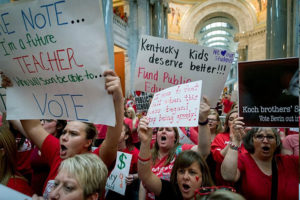
As the current labor laws and union bureaucracy forbid direct action, we will begin establishing factory and strike committees made up entirely of rank-and-file workers. These committees will re-democratize the unions. The initial step in this direction is the creation of militant rank and file caucuses of teachers and education workers, run on the basis of workers’ democracy that groups the best fighters among them. These new factory and strike committees, and union caucuses, will not adhere to parameters dictated by the state, but will act according to the decisions taken by the rank and file, basing their actions on fulfilling the workers’ own needs.
Opposing and countering anti-labor laws is the reason unions came into being, so let us organize around the paradigm of democratically run unions. The National Labor Relations Act states that the union is the sole bargaining agent; however, the workers’ bargaining agent should only be a group that serves their interests, such as our factory, workplace or school strike committees. We must reject all proposals for arbitration, mandatory cooling-off periods, and mediations. We should demand the repeal of anti-labor legislation and disband the NLRB.
As teachers are one of the few labor groups who remain mostly organized nationwide, this teacher’s uprising could reinvigorate the labor movement as a whole. Before that can happen, the teachers need to coordinate across state borders, creating a coast-to-coast amalgamated labor movement that will attract workers from all industries through mutual and effective solidarity in all struggles.
Why Join a Socialist Organization Like the Left Party?
Socialists formed the first unions to uphold socialist principles, so it makes sense for brave and proud educators, as well as any and all fighters in every section of the working class, to turn to a socialist organization like the Left Party—an organization that offers itself as an organizing tool and an association for fighting teachers during this exciting journey through the new labor landscape.
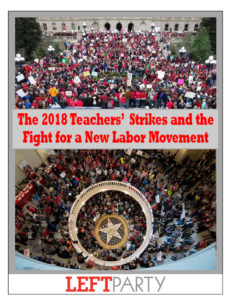
Teachers and students alike should join a socialist organization that resists capitalist hegemony in our classrooms and society, promoting the development of a much broader revolutionary movement. Only a revolutionary socialist party (like the Left Party) will promote the necessary break with the bourgeois parties of war, imperialism and class exploitation to build independent socialist replacements, both on the ballot and on the streets. Socialists propose to defeat all forms of racism and discrimination, oppose imperialism and militarism, and raise the prospect of a society based on social justice and equality.
Socialists propose that schools would no longer use examinations as a tool to divide students socially or economically. We oppose standardized testing that lumps all students in the same bag and utilize the results as a weapon to cut funding for schools. If the students and teachers decide to use assessments, they would be customized for the individual students and only utilized for helping them to measure their own capabilities and progress.
Socialists propose 100% public education, the closing of private schools, and the passing of their assets to the social ownership of the educational system, the complete separation of state and church and a secular, scientific, and egalitarian education for all, from kindergarten to PhD, at no cost to students or their families.
If you agree with these proposals, we invite you to join the Left Party. Together we can build a force to fight for democratic and militant unions; the unity of teachers within the working class and their communities; and political independence from bosses, parties, and the rich whom they serve.
This is your fight. This is our fight. Let us take the fight nationwide and industrywide.●
You can also follow us in Facebook
www.facebook.com/InternationalLeftReview
leftpartyus@gmail.com – (415) 532-7720